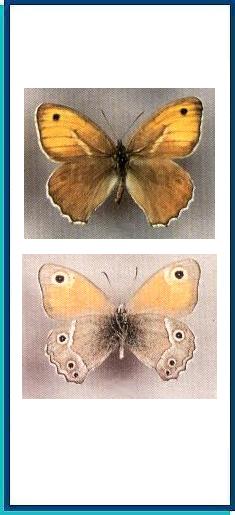LEPIDOPTERA
S A T Y R I D A E Boisduval, 1833
HYPONEPHELE Mushamp, 1915
Hyponephele argyrostigma Tuzov et Samodurov, 1997
Hyponephele argyrostigma Tuzov et Samodurov, 1997

· HOLOTYPE: 10 km S. of Pass Khaburabod, 2,200 m a.s.l., Darvazsky Mts., 11.07.1984, leg. V. Tuzov; ex coll. V. Tuzov.
· PARATYPE:, Pass Gushkhon, 2,300 m a.s.l., Vanchsky Mts., 1.08.1989, leg. S. Sazonov.
The type specimens are deposited in the collections of the State Darwin Museum and V. Tuzov.
· DESCRIPTION. Male (holotype). FW length 23 mm (paratype 22 mm). UPS as in H. dysdora, ground colour brown; UPF with an ochreous-yellow field in outer half of wing and with a rather large black-brown blind apical ocellus. A silky and silvery androconial field, similar in shape to that of H. dysdora, very prominent. HW outer edge strongly dentate, as in H. tenuistigma; UPH uniformly brown. UNS as in H. tenuistigma, but UNF outer field lacking the dark transverse stripe characteristic of all species of the davendra-group and absent from all species of the dysdora-group. UNH as in H. tenuistigma, but white pupils of anal and tornal ocelli less strongly pronounced: both type specimens with traces of white pupils only in one apical and one tornal ocellus. (In the dysdora-group, the ocelli are always without white pupils.) UNH apical ocelli larger than tornal, in contrast to the davendra-group in which the apical ocelli, if present, are always smaller than the tornal ones. Androconial scales as in H. dysdora.
Male genitalia (Fig. 68) similar to those of H. dysdora, except for the tegumen which is more massive in both males at hand.
· RANGE. Darvaz, the W. Pamirs.
· NOTES ON TAXONOMY. So far only two specimens are known of this taxon, which combine characters of two similar species, H. dysdora and H. tenuistigma. Therefore, the possibility cannot be excluded that we deal with hybrids. However, the fact that no other hybrids have been found among thousands of Hyponephele specimens examined points against this suggestion. Apparently, a final solution of this problem can be achieved only upon additional material gained and studied.
· HABITAT AND BIOLOGY. Both specimens at hand have been taken on dry steppe argillaceous slopes at 2,200-2,400 m a.s.l. Flight period: July.
· SIMILAR SPECIES. The differences from the similar species, H. tenuistigma and H. dysdora, are discussed in the description.
Photo and text: Guide to the BUTTERFLIES OF RUSSIA and adjacent territories Volume 1. PENSOFT, Sofia - Moscow. 1997